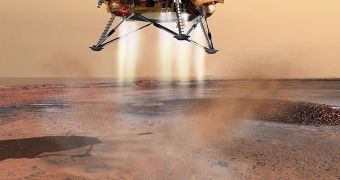The Phoenix Mars Lander was arguably one of the most successful NASA missions to Mars, and not necessarily in terms of endurance, but when considering the scale of its discovery. Born out of a previous lander's failure, the robot managed to successfully land on the Red Planet in search of water-ice and touch down right in it, experts believe. But, given the nature of its landing site, it succumbed to the Martian cold after a few months. Now, experts think it may be resurrected.
The lander was originally scheduled to last for only three months, but it managed to stay in contact with the Earth for more than five. It touched down in a region located at northern latitudes on the planet that encircled the northern polar areas. The lowland terrain is known as Vastitas Borealis, and Phoenix aimed for a feature informally known as Green Valley. Experts believed that the landscape feature might have been submerged in water at one point, when the liquid still endured on the surface of the Red Planet. The northern hemisphere is believed to have hosted an ocean billions of years ago.
The lander touched down on May 25, 2008, and the last communication contact with it took place on November 2 the same year. The mission was officially concluded on November 10, which was the date when funding for it was scheduled to run out. The Jet Propulsion Laboratory (JPL) engineers that were managing the spacecraft were unable to contact it beyond that date, but they knew that the craft had been left in a minimally state of “consciousness,” known as a safe-mode. They hoped that the next Martian spring would bring enough solar power to the lander to allow for an “awakening” attempt, and this is scheduled to happen in January 2010.
“We start listening in January for signals from our lander. Our engineering team is quite curious to see how resilient the electronic systems are to the extreme cold of northern winter,” University of Arizona in Tucson (UAT) Lunar and Planetary Lab Phoenix principal investigator Peter Smith says, quoted by Space. “While the recovery of Phoenix is improbable given the severe conditions that it has endured throughout the winter, the science that can still be accomplished makes the mission worth continuing.” The craft was tested at minus 55 degrees Celsius, but the Martian winter temperatures can go down to as much as minus 126 degrees Celsius.
One of the good things is that all the equipments on Phoenix were shown to be fully operational when the spacecraft made its last transmission. Lockheed Martin Space Systems, the company that built the craft, also integrated what it called a “Lazarus Mode” into it, which is basically the ability for Phoenix to re-energize itself, if given the proper conditions. However, there is no way of telling how the solar panels, its main source of energy, handled the Martian winter. “We were just ready to begin a campaign to measure the thermal and electrical properties of the soil using the thermal and electrical-conductivity probe (TECP) instrument on the robotic arm,” the expert says.
“Clearly, future use of Phoenix instruments depends on the health of the system. If it fully recovers then we would start with an imaging campaign and measure soil properties with TECP, then progress to digging beneath the surface to see if the ice table has changed depth. Throughout these activities, a complete investigation of the weather conditions […] along with wind measurements is envisioned,” Smith adds.

 14 DAY TRIAL //
14 DAY TRIAL //